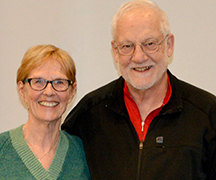- CEMC Home
- About Us
- Contests
- Courseware
- CEMC Digital
- CEMC in Person
- Books
- Master of Mathematics
for Teachers - Educator Development
- Make a Difference
- Frequently Asked
Questions
Donor Profile
Making Math Education Part of the Family Legacy
Donors Paul and Cathy Cotton get behind the CEMC to extend Math and Computer Science outreach to those who need it most.
by Lisa Kabesh
It was 1987 when Paul and Cathy Cotton made their first donation to the University of Waterloo.

They soon established endowments for two undergraduate scholarships in mathematics, the first in honour of Paul’s parents and the second in honour of Cathy’s. It wasn’t long before they created a third scholarship to recognize the Cotton’s daughters, who earned graduate degrees in mathematics and medical genetics, and to help attract the best female math graduate students to Waterloo.
Combined, the three scholarships have helped 53 talented students pursue degrees in the Faculty of Mathematics since 2002.
Now the pair are setting their sights on the Centre for Education in Mathematics and Computing.
“The CEMC exposes kids to opportunities they might never have thought existed, and that’s really important to us,” says Paul.
“As an organization, it’s a great example of what we’re trying to do – reach people who wouldn’t normally attend university or think about going to Waterloo.”
Opportunity paves a path to a rewarding career at STEM
Paul Cotton’s career in programming and computer standards can be traced back to his high school days, where connections to the University and opportunities to compete in math contests put Paul on the path to study math at Waterloo in the late 1960s.
“The personal connection really works,” explains the IBM and Microsoft veteran, “and that’s what the CEMC is all about.”
When Paul was in Grade 11 Ralph Stanton made a visit to his school in Thunder Bay in northern Ontario. Then a professor at the University of Manitoba, Stanton was Waterloo’s first mathematics professor and head of the Mathematics Department. His efforts resulted in Waterloo becoming the first university in North America to have a dedicated Faculty of Mathematics.
Stanton and other Waterloo professors like Ken Fryer introduced Paul and his classmates to mathematics contests, and Paul would go on to compete in contests until he graduated from high school.
Opportunities for deep learning in math and computer science didn’t stop there for the young Paul Cotton. Paul was able to take a remote programming course in Grade 13.
“The University of Waterloo was my cloud computing facility,” Paul jokes. “As part of the course, I coded programs in Fortran, punched up the cards and sent them to Waterloo where someone ran the program, corrected minor errors and mailed back the results.” Paul studied computer science at Waterloo, where he met his wife Cathy, who studied applied math and, later, statistics. Cathy enjoyed a 35-year career at Statistics Canada, where she served as assistant director, income statistics and then health statistics, before retiring.
The Cotton Family Charitable Foundation
The Cottons are very much aware that Paul benefited from the type of opportunities that the CEMC offers kids around Canada today, like the CEMC Visits Schools program and its contests and workshop series.
They are now committed to helping the CEMC spread its outreach programs to reach even more young people, especially kids in remote communities, Indigenous students, and girls and young women.
From the couple’s own parents to their two daughters, the Cottons can point to three generations committed to mathematics and higher education. They created the Cotton Family Charitable Foundation to carry on a family legacy of giving back.
“It’s part of our legacy, and hopefully our daughters’ and grandkids’ legacy, too.”




 CEMC
CEMC